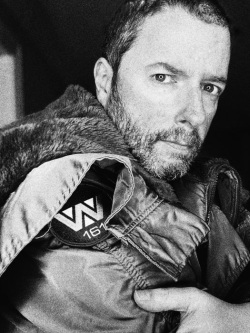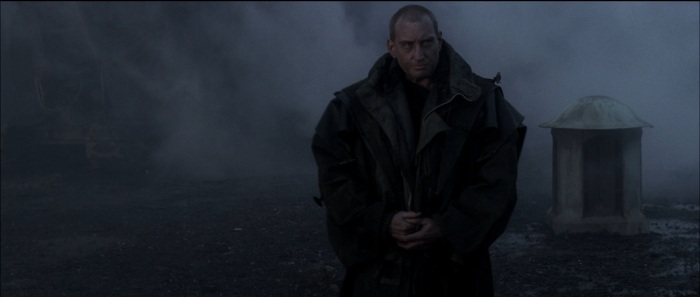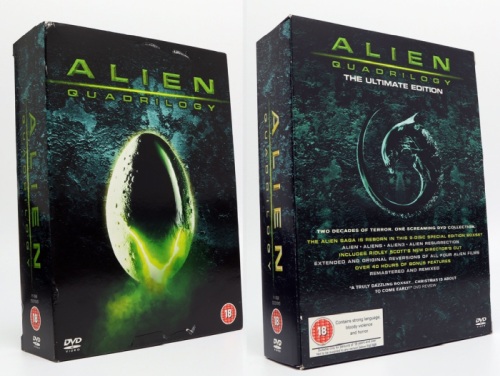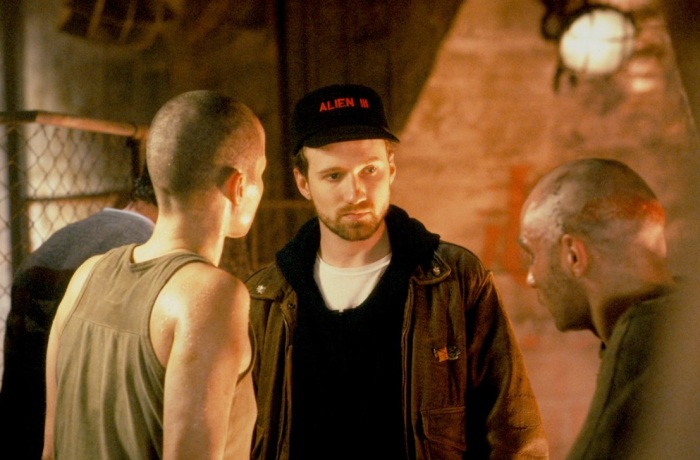Charles De Lauzirika Interview #2
Posted by Darkness on June 24, 2020 (Updated: 22-Aug-2023)
In May 2020, we sat down with DVD/Blu-Ray producer Charles De Lauzirika in episode #107 of the AvPGalaxy podcast. We last spoke to Charles very early on in our podcast series back in 2014 and that one covered the Alien Anthology and Prometheus Blu-Ray sets. This interview is mainly about producing the Alien 3 Assembly Cut. The Assembly Cut was first released as part of the Alien Quadrilogy boxset and added 30 minutes to Alien 3. You can check out the Alien 3 Deleted Scenes page which covers the differences between the Theatrical, Assembly Cut and Workprint. You can listen to the full interview or read one for a transcript of the most important questions.

Charles De Lauzirika
Aaron: We’re here today specifically to talk about Alien 3 but before we start talking the Assembly Cut, I wanted to just ask you about Alien 3 in general. It was your desire to produce a behind-the-scenes documentary on Alien 3 the made you take the job of tackling the entire bloody [Alien] series. So, what is it about Alien 3 that made you so willing to take on such a huge workload? Were you a fan of the theatrical release of the film?
I remember seeing the theatrical release. It was opening day at the Avco theater in Westwood in LA and I watched it. You have to understand, I went into Alien 3 as a huge fan of the first Alien and I like Aliens but it was just such a different beast from the first film in terms of it being much more action and kick-ass and lock and load, let’s go kill some bugs. A different vibe entirely from the first film but still incredibly entertaining and successful with just a lot of incredible fun iconic moments.
So as someone who had Alien imprinted on my brain – that’s the Alien universe I want to really stick to. Aliens is a departure and a fun departure but Alien 3 looked like we’re gonna go back to that haunted house, gothic horror vibe of the original Alien. So I was looking forward to that even though the trailers made it seem very actiony and even used James Horner’s music from Aliens. But I watched it and immediately I just felt like “this is a very interesting nightmarish take on Ripley’s story and the Alien universe” and it was very – no pun intended – very alienating.
Right off the bat, you kill Hicks, you kill Newt. It’s vicious in terms of how it starts and it doesn’t really let up in terms of giving you any room to breathe. I mean even Ripley has her brief little romance with Clemens and that’s nice because Charles Dance did a wonderful performance in that role. I’m not gonna say it was sweet but it was like this welcome breath of relief for Ripley who’s been surviving this ordeal for years and years. Even Clemens gets wiped out – like really shortly after we get to really like him as a character.
What I was intrigued by with Alien 3 right off the bat was, it sent a clear message to the audience that no one was safe and, in the end, we found out no one was. Even Ripley, our hero, didn’t make it so I thought it was an incredibly bold film and before I actually saw Alien 3, I had been sort of studying Fincher’s music videos and commercials quite a bit because I was a huge fan of his work in that realm. So, I kind of went in rooting for him and then the film ended and the credits began and that my first thought was “it’s too bad he’s never gonna work again.”
I thought he was so incredibly talented and this film was such a disaster in terms of, again, alienating the audience. It really was not popcorn fare. It wasn’t what people wanted in May of 1992. It’s like they wanted escapism. They want to get back to the Aliens action horror vibe, I guess. They wanted Ripley to go in and wipe out the Alien once and for all. Whatever that was supposed to be in their imaginations, it wasn’t that and even me who loved the original film, it wasn’t that either. So it’s a very interesting, magnificent train wreck of a movie that I was just immediately fascinated by.
It’s like when you meet people and someone’s got issues but that intrigues you and you want to learn more about what those issues are. So it’s kind of like I feel like Alien 3 was that and obviously in that moment, I didn’t think “oh man, I hope there’s some lost cut of the film that we can restore and put together” because I wasn’t even thinking about home video or directors cuts or anything back in 1992. So it was like a year or two after when this bootleg VHS tape came my way of the workprint of Alien 3 that had been screened at that test screening. That’s when I realized “oh there’s all this other stuff there” and by the way this did not include the opening scenes of Clemens walking on the beach or the ox or the abattoir.

Clemens on the beach.
Like any of that stuff was not in this cut but it was still longer and there’s still more stuff in it. There was Golic but it didn’t have any of that big epic sweep that we had seen glimpses of in stills that had gotten out. So that that got my imagination going about what else is there? What more could there be of Alien 3 and then that thought I filed away on a shelf in my brain and didn’t even think about it for years and years until when I started working on DVD projects and we were working on the 20th anniversary Alien Legacy box set and my job specifically was Ridley’s supervisor on that set so I was focused entirely on Alien but I knew they were doing the other three movies for the box set and I just happened to talk to someone at Fox who’s no longer there and I just said “Alien 3 is a really interesting backstory and you can do a lot of really cool stuff with Alien 3.”
There is a new cut or documentary whatever and the response I got back from this person was “it’s not your movie, don’t worry about it.” That to me was like “oh so there’s not really much interest in going into Alien 3 and doing a home video autopsy on the film to figure out what went wrong, what’s interesting, what could be salvaged?” So after that first box set of the Alien Legacy came out, every once in a while I get a call from Sven Davison who’s also no longer at Fox. He was like my point person at Fox and he asked “would you want to put together a five star collection of Alien?”
Which was a limited series or whatever Fox was doing – almost like their version of Criterion – like a high end elite release and I kept asking “well we just did Alien pretty well I think. There was a good box that came out. Why don’t we do Alien 3 because that’s the one where there’s a whole bunch of treasure that has not been explored or unearthed” and the response is always like “well no probably not” and they always drifted away from that conversation. Then like once a year I get that call, or once every six months or so, until finally I think the third time Sven called me and he said “so would you want to do a five star Alien?”
I said “well how about a five star Alien 3?” And that’s when he said “how about you do all four?” And that’s when I went “woah!” Be careful what you wish for. So, what began as a set that was basically four five-star releases of those films. When we realized how much material was not only pre-existing and not only how much there was in the way of deleted scenes and opportunities to do special edition cuts of these films. The same way that Aliens had had done years before for laserdisc, it just morphed into this bigger thing which was the Alien Quadrilogy.
Aaron: You just mentioned the laserdisc Aliens. For a little over ten years, Aliens was the only film that had an alternate edition and then 2003 rolls around. At the end of the year, at Halloween, we get the, in name only, Director’s Cut of Alien in the cinema and then the Quadrilogy comes out November, December time and we get alternate cuts of everything.
I’m a little fuzzy on the chain of events that led to the decision to do alternate cuts of everything. Was it a case of you already had Alien, Alien 3 and Resurrection in the works for the Quadrilogy and then Fox decided to give Alien DC a theatrical release? Or was it a case of the DC was already in the works, there’s two already there, let’s do all four of them?
No. We were working on the special edition versions of Alien, Alien 3 and Alien Resurrection simultaneous with the documentaries and all the bonus features so we were doing that all at the same time. The plan from the very beginning was to create alternate cuts of the other three non-Aliens movies. That was from the get-go and that was more out of like a sense of… we know there are a lot of deleted scenes from Alien – some which had never even been released at that point. Not even previous releases.
We assume there’s deleted material from Resurrection because the script had other scenes that weren’t in it. We know for sure there’s some lost bounty of stuff on Alien 3 somewhere. So basically, we said let’s just go about and try to create a uniformity that can be a nice match for Aliens – having the theatrical cut and the special edition cut. So, all four began as special editions. It was literally like all of our proposals said Alien Special Edition, Alien 3 Special Edition and so on.

Alien Quadrilogy released in 2003.
It wasn’t really until late in the game when Fox decided they wanted to release Alien theatrically – the new cut of Alien around Halloween as you said. I guess someone there felt like it would be more exciting to call it a Director’s Cut and that’s like a lot of conversations are happening like “well it’s not really a Director’s Cut. Yes, the director is cutting the movie but it’s not the traditional definition of the term Director’s Cut.” That’s why the booklet in the Quadrilogy does a lot of tiptoeing and tap dancing around mines to try to explain that that was the case.
So that was basically just I think a way for them to drive interests in the upcoming Quadrilogy box set. So, Alien comes out for Halloween. It’s a great scary movie. People get to go see in the theatre again plus they see a new version which now is called the Director’s Cut and then that gets them excited in time for the holidays where they get to buy the new box set. So, from a marketing standpoint it makes total sense. I totally get it from an Alien nerd purist standpoint like it’s a little wordy in terms of it’s a little tricky but it’s fine.
I was always of the mindset so long as the directors’ preferred cut was available, you call it whatever you want. That will get us eventually to Alien 3 in terms of calling it, in the blu-ray version, the Assembly Cut which was also done without my input. I really kind of wish we’d had that conversation before that term got locked into menus and packaging and things like that because an assembly is when you cut together all the footage you shot in a really rough kind of … basically just laying out the entire film so you know what you’ve shot.
You lay it out in narrative order but it’s a string out of everything so that the filmmaker knows what they’ve shot. They know what they might be missing. What they might need to improve and reshoot. Just so they know what they’ve got and so many times we see in interviews with people, editors, directors they say “oh the first cut was four hours long.” They’re talking about the assembly. That’s not really a version you want to watch and enjoy. Now if you’re an uber nerd and you just want to see all the raw footage in narrative form basically roughly cut together into something approximating the movie, sure. But these four hour cuts you hear about – those are most likely assemblies that are not meant to be seen by anyone except for the filmmakers.
Aaron: Then it’s the workprint, isn’t it?
So workprint comes from when people used to cut on film right. So basically, it was a print that you would cut, like physically cut and tape and glue and all these things were as physical. So, a lot of times when you screened it at a test screening, it was a film print that was cobbled together. I mean I’m talking like early days. It got more technologically refined as time went on but the workprint idea comes from the fact that you get physical film, photochemical film from the lab. As an editor you start cutting that thing up physically.
You start taping together physically. It’s not like on a nonlinear editing system where you can just make a million versions of the film. You make a cut. You realize “I am cutting this thing and I have the fix this. So, if I chop it up so hard that I have to go request a new print of this from the lab, I know I’m really either doing something wrong or the director is really being super indecisive about stuff.” I edited on film when I was in film school and I always remember when you had the movie that you were cutting on the Steenbeck stand-ups I believe they were called.

David Fincher
You’d hit the brake to stop what you’re doing. You’d watch it, it’d go through and then you hit the brake. You take a grease pencil, you’d mark it. Then if you’re happy with that mark, then you would maybe cut it and then you’d maybe tape it to another piece of film and that’s how you’d cobble together the movie. So workprints kind of come from that mindset and then it’s really just a term that kind of that continued on with the gray area between film and in digital. Things like the Blade Runner Rick workprint.
That was known as the workprint because the cut what you’re seeing was kind of like born from all the work that Terry Rawlings had done in terms of actually physically cutting the film. So again, these are terms that are kind of used loosely sometimes. They’re not always 100% accurate but at least you know what you’re talking about when you say “oh the workprint of this, or the Assembly Cut of that” – it’s just a name but don’t take it seriously as a definition. Sometimes you do but sometimes you don’t.









